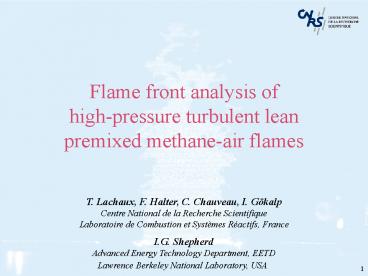Prsentation PowerPoint PowerPoint PPT Presentation
1 / 15
Title: Prsentation PowerPoint
1
Flame front analysis of high-pressure turbulent
lean premixed methane-air flames
T. Lachaux, F. Halter, C. Chauveau, I.
Gökalp Centre National de la Recherche
Scientifique Laboratoire de Combustion et
Systèmes Réactifs, France
I.G. Shepherd Advanced Energy Technology
Department, EETD Lawrence Berkeley National
Laboratory, USA
2
Introduction
- This work is aimed to provide experimental data
enabling validation of numerical models and to
have a deeper knowledge of combustion under
high-pressure - Many practical power applications such as gas
turbines or spark ignited internal combustion
engines use premixed hydrocarbon-air flames. Only
few laboratory scale studies exist under
high-pressure conditions Kobayashi et al.,
Soïka et al..
3
The combustion chamber
- P up to 0.9 MPa, set by valve
- H 1200 mm D 300 mm
- Large value of D for free jet
- Walls are water-cooled
- Windows diam. 100 mm at 90
- Internal walls painted in black
- Monitoring of P and T
- Burner can move axially
- 2 mass flowmeters for Air and CH4
- N2 to remove condensation
4
The Bunsen burner
- Axisymmetric D int. 25 mm, H 230 mm
- Mean flow velocity 2.1 m/s
- Equivalence ratio f 0.6 (Gas Turb.
applications) - Turbulence by a perforated plate u/ U 8
- Pilot flame CH4-Air f 1,flow rate lt 7 of the
main flow rate
- Mesh 3.5 mm
- d 2.5 mm
- s 50
5
Flame at equivalence ratio of 0.6
Example of a flame atequivalence ratio of 0.6
andatmospheric pressure
6
Data on the laminar flame
- Few data are available for SL vs. P at f 0.6
- Data obtained with CHEMKIN II and PREMIX code
- 219 i.o 325 reactions (no N2 oxidation
mechanism) - SL decreases with increased P especially below
5 atm - low values at high pressure
7
Velocity measurements in cold flow
At 5 mm above the burner axis
lt is obtained by autocorrelation
u constant lt constant
n a P-1 Ret a P h a P-3/4 ?g a P-0.5 or Ret-0.5
8
Flame structure - visualization
Flame at 0.1 MPa
Flame at 0.9 MPa
- Curvature and orientation change with P (2 D
measurements !!) - The flame wrinklings become sharper (cusps).
9
Laser tomography
From left to right raw picture, after
binarization,flame edge and isoltCgt
X / Radius
10
Flame structure orientation angle
- The orientation angle is symmetrical
- The distribution becomes flatter
- The distr. changes with the 1st increase of P
and remains constant - Cusps appear with P
40 at 0.1 MPa
65 at 0.9 MPa
11
Flame structure orientation angle and crossing
length
- Lb and Lu decrease with P
- ? a Ret-0.5
12
Flame structure curvature
- The distribution moves toward low R values
(cusps) - The variance of h increases linearly with lt/?
(a Ret0.5) - The distribution is symmetrical
- Curvature h 1/R, lt R gt / ? 1.2 to 1.6
13
Flame structure flame surface density
(mm-1), nf number of images
14
Flame structure flame surface density
- The flame surface density increases with P
(smaller curvatures)
15
Conclusions
- A combustion chamber and a Bunsen burner with a
simple geometry are a good way to understand
fundamental turbulent combustion processes
occurring under pressure. - When pressure increases
- The pressure influences both turbulence and
combustion by decreasing of n (turbul.) and SL
(comb.). - The eddies become smaller, u' and lt remain
constant, the wrinkling becomes finer, cusps
appear. - The flame surface increases and hence flame
surface density.

